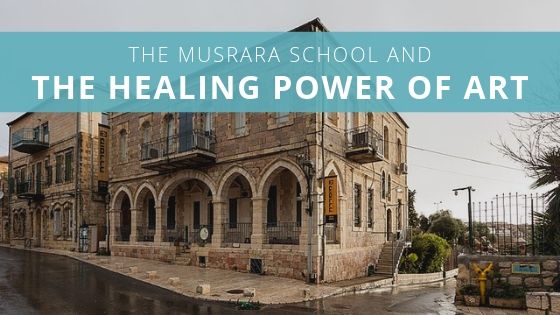Creative Community For Peace (CCFP) recently visited Musrara: The Naggar Multidisciplinary School of Art and Society and spoke with people who are blending art and social activism to improve their neighborhood, their city, and their country.
The school brings artists from all over Israel to the Musrara neighborhood of Jerusalem in order to learn and to create. Students can choose from five different tracks: Photography, New Media, New Music, Visual Communication, or Phototherapy.
One of the things that separates the Naggar school from other art schools is that they encourage students not only to achieve artistic excellence in their fields, “but also to generate social change by contributing to and empowering the weak through community-based artistic volunteerism in Jerusalem and nationwide.”
This commitment to volunteering and social change is a big part of the reason why the school was located in the Musrara neighborhood. In 1987, when the school was founded, the neighborhood was in poor shape.
As a result of the conflict between Israel and Jordan, which each controlled half of Jerusalem between 1949 and 1967, Musrara was located in a no man’s land between the opposing sides. Residents of the neighborhood were often subjected to attacks by Jordanian snipers. As one can imagine, not many people wanted to live there.
However, during this time, hundreds of thousands of Jews were fleeing or being expelled from Arab countries and needed homes in Israel. Many of them, particularly those from North Africa, were settled in Musrara by the Israeli government. The neighborhood became a place of unemployment, poverty, and isolation, and remained that way for some time, even long after the war ended.
Mr. Sabag told CCFP that Musrara was not a neighborhood people were proud to say they were from. This negative perception was one of the things he set out to change when he founded the school, by bringing artists to interact with the community.
At the Musrara school, the artists don’t simply create art in the community or for the community, Mr. Sabag stressed. Rather, they create art together with the community. And the school doesn’t only affect the community, the community affects the school.
“The school operates in a real life space,” he said. “It’s affected by its immediate environment. Its identity as an art institution is sharpened by the history of the neighborhood and the history of the social struggle which strived to bridge the gaps in Israeli society.”
One example of the school’s current integration with the community is the Musrara Mix Festival. The school works with the community to install works in buildings throughout the neighborhood, in public spaces, and even in the backyards of the residents. The point is for the festival to be part of the neighborhood and for the residents of the neighborhood to have a stake in the festival.
While the heart and soul of the school is certainly centered around Musrara, they also look further afield. One of their programs, for instance, is a workshop for Arab women, teaching photography to Arab women from eastern Jerusalem and empowering them to become leaders in their community. And the general message of the intersection between art and social activism is a constant throughout the school.
“The parallel lines between the artistic field and the social field have been revealed to me, and continued to be revealed throughout my years of study and creativity,” said Yafit Reuveny, an alumni of the New Music Department. “They continue to be a significant factor in the narrative I create in my works.”
We at CCFP — an organization comprised of prominent members of the entertainment industry dedicated to promoting the arts as a means to peace, defending artistic freedom, and countering the cultural boycott of Israel — are strong believers in the power of the arts to create positive social change, and we’re happy to see the Musrara School validating that belief in Jerusalem.

